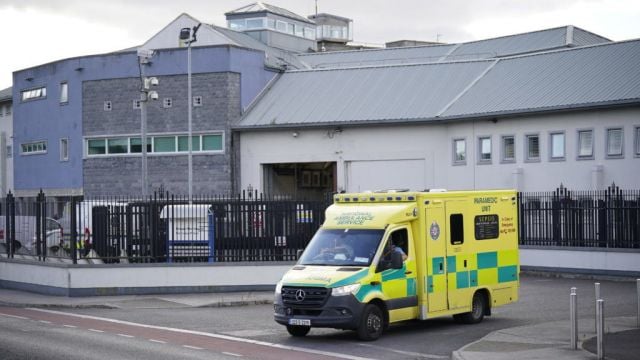Overcrowding is contributing to the drugs problem in Irish prisons, a human rights charity has said, as 10 inmates at Portlaoise Prison were rushed to hospital on Tuesday for suspected overdoses.
A number of inmates were taken to hospital by ambulance on Tuesday after the suspected overdose incidents while others received treatment at the prison.
The Irish Prison Service (IPS) said it was “working closely” with the HSE in response to a number of overdose presentations in custody.
The prison service said “extra vigilance” was being taken and added that extra naloxone kits, which are used in the treatment of overdoses, had been secured.
Saoirse Brady, the executive director of the Irish Penal Reform Trust, said prisons were “overstretched” with a record number of people incarcerated and the penal system operating at 112 per cent capacity.
Portlaoise Prison was operating at 107 percent capacity this week, she told RTÉ radio’s Morning Ireland.
“That means that people are doubling and tripling up in cells. They may be sleeping on mattresses or beside the toilet. So there's huge pressure on our prison system at the moment.”
Ms Brady said prison was a “traumatic experience” for anyone. “But with the overcrowding levels at the moment, it is even more traumatic. We know there are 2,000 people on mental health waiting lists within the prison system at the moment. We know that people are leaving prison, but returning maybe shortly afterwards because they're falling into the same pattern over and over again.
“I would argue that if you can treat an addiction or a mental health issue in the community, then people may not reach crisis point.”
Ms Brady added that prisons were a microcosm of society. “So all the things that lead to drug use and substance misuse outside of prison, are amplified within the prison system because obviously you have a situation where you don't really have any outlets as well.
“When you have an overcrowding situation, the first thing that is closed is the gym, prison schools are closed. Those are outlets for people, to be able to focus on something else to direct their life in a different way. But if you have those closures, coupled with the lack of supports that are in place, it is very difficult for them to maybe move on from their addiction.”
Ms Brady pointed out that there had been recommendations from the Office of the Inspector of Prisons recently following a death in prison earlier this year, but prison authorities had said that they could only accept recommendations that were operationally feasible.
Detective Chief Superintendent Seamus Boland, head of the Garda National Drugs and Organised Crime Bureau, said that the HSE and the Department of Health had “pre-planned” for an event such as the overdoses of prisoners in Portlaoise on Tuesday.
Speaking on RTÉ radio’s Morning Ireland, Chief Supt Boland said that it had been known for some time that there was a danger from synthetic opioids such as nitazine. This was why it was so important that the health service was prepared for clusters of overdoses, he said.
In a statement, the IPS said preventing drugs and other contraband from entering prisons was a high priority.
It said: “The Irish Prison Service has committed to continuing to invest in new technologies and measures to support our efforts to keep contraband out of prisons.
“Prison staff have increased the use of random and intelligence-led cell searches on a daily basis. Our Canine Unit carry out searches around the prisons, including a greater focus on searching deliveries into prisons.
“The Irish Prison Service continues to engage with An Garda Síochána with regard to preventing contraband entering our prison and this happens at both local and national level.”
It has also carried out an information campaign for prisoners about the dangers of drugs.
The Department of Justice declined to comment on the incidents.
It comes less than a month after the IPS issued an urgent drug alert to all prisons about a “nitazene-type substance” following a fatal overdose.
The HSE National Drug Treatment Centre Laboratory was involved in confirming the presence of the drug.







